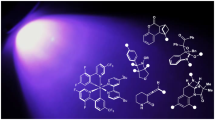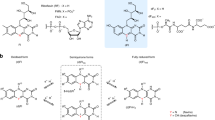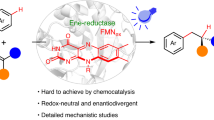Abstract
SOME confusion has recently arisen over the nature of the pigments derived from d-urobilin (I) by treatment with methanolic ferric chloride in the presence of hydrochloric acid. Watson1 claims that this urobilin, after treatment for 15 min. under conditions similar to those described below, affords mainly glaucobilin (II). This finding differs from our own2, which suggested that mesobiliviolins were the main products. Watson obtained mesobiliviolin only after brief treatment of d-urobilin with ferric chloride.
This is a preview of subscription content, access via your institution
Access options
Subscribe to this journal
Receive 51 print issues and online access
$199.00 per year
only $3.90 per issue
Buy this article
- Purchase on Springer Link
- Instant access to full article PDF
Prices may be subject to local taxes which are calculated during checkout
Similar content being viewed by others
References
Watson, C. J., and Weimer, M., Fed. Proc., 18, No. 1377 (1959) ; and Watson, C. J., private communication.
Gray, C. H., and Nicholson, D. C., J. Chem. Soc., 627, 3085 (1958).
Siedel, W., Z. physiol. Chem., 237, 8 (1935).
Lemberg, R., and Legge, J. W., “Hæmatin Compounds and the Bile Pigments”, 130–133 (Intersci. Pub., New York, 1949).
Baker, J. W., “Tautomerism”, 51 (Routledge, London, 1939).
Author information
Authors and Affiliations
Rights and permissions
About this article
Cite this article
GRAY, C., NICHOLSON, D. Violinoid Products of Oxidation of d-Urobilin. Nature 185, 380–381 (1960). https://doi.org/10.1038/185380a0
Issue Date:
DOI: https://doi.org/10.1038/185380a0
Comments
By submitting a comment you agree to abide by our Terms and Community Guidelines. If you find something abusive or that does not comply with our terms or guidelines please flag it as inappropriate.



